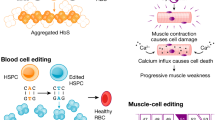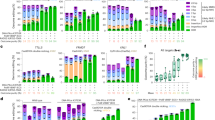Abstract
Permanent modification of the human genome in vivo is impractical owing to the low frequency of homologous recombination in human cells, a fact that hampers biomedical research and progress towards safe and effective gene therapy. Here we report a general solution using two fundamental biological processes: DNA recognition by C2H2 zinc-finger proteins and homology-directed repair of DNA double-strand breaks. Zinc-finger proteins engineered to recognize a unique chromosomal site can be fused to a nuclease domain, and a double-strand break induced by the resulting zinc-finger nuclease can create specific sequence alterations by stimulating homologous recombination between the chromosome and an extrachromosomal DNA donor. We show that zinc-finger nucleases designed against an X-linked severe combined immune deficiency (SCID) mutation in the IL2Rγ gene yielded more than 18% gene-modified human cells without selection. Remarkably, about 7% of the cells acquired the desired genetic modification on both X chromosomes, with cell genotype accurately reflected at the messenger RNA and protein levels. We observe comparably high frequencies in human T cells, raising the possibility of strategies based on zinc-finger nucleases for the treatment of disease.
This is a preview of subscription content, access via your institution
Access options
Subscribe to this journal
Receive 51 print issues and online access
$199.00 per year
only $3.90 per issue
Buy this article
- Purchase on Springer Link
- Instant access to full article PDF
Prices may be subject to local taxes which are calculated during checkout






Similar content being viewed by others
References
Sedivy, J. M. & Joyner, A. L. Gene Targeting (Oxford Univ. Press, Oxford, 1992)
Yanez, R. J. & Porter, A. C. Therapeutic gene targeting. Gene Ther. 5, 149–159 (1998)
Kohn, D. B., Sadelain, M. & Glorioso, J. C. Occurrence of leukaemia following gene therapy of X-linked SCID. Nature Rev. Cancer 3, 477–488 (2003)
Persons, D. A. & Nienhuis, A. W. Gene therapy for the hemoglobin disorders. Curr. Hematol. Rep. 2, 348–355 (2003)
Thomas, K. R., Folger, K. R. & Capecchi, M. R. High frequency targeting of genes to specific sites in the mammalian genome. Cell 44, 419–428 (1986)
Brown, J. P., Wei, W. & Sedivy, J. M. Bypass of senescence after disruption of p21CIP1/WAF1 gene in normal diploid human fibroblasts. Science 277, 831–834 (1997)
Bunz, F. et al. Targeted inactivation of p53 in human cells does not result in aneuploidy. Cancer Res. 62, 1129–1133 (2002)
Miller, J., McLachlan, A. D. & Klug, A. Repetitive zinc-binding domains in the protein transcription factor IIIA from Xenopus oocytes . EMBO J. 4, 1609–1614 (1985)
Tupler, R., Perini, G. & Green, M. R. Expressing the human genome. Nature 409, 832–833 (2001)
Pavletich, N. P. & Pabo, C. O. Zinc finger-DNA recognition: crystal structure of a Zif268-DNA complex at 2.1 Å. Science 252, 809–817 (1991)
Klug, A. Protein designs for the specific recognition of DNA. Gene 135, 83–92 (1993)
Choo, Y., Sanchez-Garcia, I. & Klug, A. In vivo repression by a site-specific DNA-binding protein designed against an oncogenic sequence. Nature 372, 642–645 (1994)
Pabo, C. O., Peisach, E. & Grant, R. A. Design and selection of novel Cys2his2 zinc finger proteins. Annu. Rev. Biochem. 70, 313–340 (2001)
Choo, Y. & Isalan, M. Advances in zinc finger engineering. Curr. Opin. Struct. Biol. 10, 411–416 (2000)
Jamieson, A. C., Miller, J. C. & Pabo, C. O. Drug discovery with engineered zinc-finger proteins. Nature Rev. Drug Discov. 2, 361–368 (2003)
Kim, Y. G., Cha, J. & Chandrasegaran, S. Hybrid restriction enzymes: zinc finger fusions to Fok I cleavage domain. Proc. Natl Acad. Sci. USA 93, 1156–1160 (1996)
Smith, J., Berg, J. M. & Chandrasegaran, S. A detailed study of the substrate specificity of a chimeric restriction enzyme. Nucleic Acids Res. 27, 674–681 (1999)
West, S. C. Molecular views of recombination proteins and their control. Nature Rev. Mol. Cell Biol. 4, 435–445 (2003)
Symington, L. S. Role of RAD52 epistasis group genes in homologous recombination and double-strand break repair. Microbiol. Mol. Biol. Rev. 66, 630–670 (2002)
Paques, F. & Haber, J. E. Multiple pathways of recombination induced by double-strand breaks in Saccharomyces cerevisiae . Microbiol. Mol. Biol. Rev. 63, 349–404 (1999)
Rouet, P., Smih, F. & Jasin, M. Expression of a site-specific endonuclease stimulates homologous recombination in mammalian cells. Proc. Natl Acad. Sci. USA 91, 6064–6068 (1994)
Sargent, R. G., Brenneman, M. A. & Wilson, J. H. Repair of site-specific double-strand breaks in a mammalian chromosome by homologous and illegitimate recombination. Mol. Cell. Biol. 17, 267–277 (1997)
Choulika, A., Perrin, A., Dujon, B. & Nicolas, J. F. Induction of homologous recombination in mammalian chromosomes by using the I-SceI system of Saccharomyces cerevisiae . Mol. Cell. Biol. 15, 1968–1973 (1995)
Bibikova, M. et al. Stimulation of homologous recombination through targeted cleavage by chimeric nucleases. Mol. Cell. Biol. 21, 289–297 (2001)
Bibikova, M., Beumer, K., Trautman, J. K. & Carroll, D. Enhancing gene targeting with designed zinc finger nucleases. Science 300, 764 (2003)
Porteus, M. H. & Baltimore, D. Chimeric nucleases stimulate gene targeting in human cells. Science 300, 763 (2003)
Cavazzana-Calvo, M. et al. Gene therapy of human severe combined immunodeficiency (SCID)-X1 disease. Science 288, 669–672 (2000)
Elliott, B., Richardson, C., Winderbaum, J., Nickoloff, J. A. & Jasin, M. Gene conversion tracts from double-strand break repair in mammalian cells. Mol. Cell. Biol. 18, 93–101 (1998)
Moore, M., Klug, A. & Choo, Y. Improved DNA binding specificity from polyzinc finger peptides by using strings of two-finger units. Proc. Natl Acad. Sci. USA 98, 1437–1441 (2001)
Buckley, R. H. Primary immunodeficiency diseases due to defects in lymphocytes. N. Engl. J. Med. 343, 1313–1324 (2000)
Schell, T., Kulozik, A. E. & Hentze, M. W. Integration of splicing, transport and translation to achieve mRNA quality control by the nonsense-mediated decay pathway. Genome Biol. 3, 1–6 (2002)
Isalan, M. & Choo, Y. Rapid, high-throughput engineering of sequence-specific zinc finger DNA- binding proteins. Methods Enzymol. 340, 593–609 (2001)
Wilson, J. H. Pointing fingers at the limiting step in gene targeting. Nature Biotechnol. 21, 759–760 (2003)
Choo, Y. & Klug, A. Physical basis of a protein-DNA recognition code. Curr. Opin. Struct. Biol. 7, 117–125 (1997)
Bibikova, M., Golic, M., Golic, K. G. & Carroll, D. Targeted chromosomal cleavage and mutagenesis in Drosophila using zinc-finger nucleases. Genetics 161, 1169–1175 (2002)
Zhang, L. et al. Synthetic zinc finger transcription factor action at an endogenous chromosomal site. Activation of the human erythropoietin gene. J. Biol. Chem. 275, 33850–33860 (2000)
Liu, P. Q. et al. Regulation of an endogenous locus using a panel of designed zinc finger proteins targeted to accessible chromatin regions. Activation of vascular endothelial growth factor A. J. Biol. Chem. 276, 11323–11334 (2001)
Isalan, M., Klug, A. & Choo, Y. A rapid, generally applicable method to engineer zinc fingers illustrated by targeting the HIV-1 promoter. Nature Biotechnol. 19, 656–660 (2001)
Tan, S. et al. Zinc-finger protein-targeted gene regulation: genomewide single-gene specificity. Proc. Natl Acad. Sci. USA 100, 11997–12002 (2003)
Acknowledgements
We are grateful to C. Case for his initial discussions with M.H.P. regarding this project. We thank Sangamo's production group for technical support; S. Brennan, C. Dent, D. Kohn, Y. Marahrens, T. Martin, C. Pabo and P. Sung for suggestions and discussions; and A. Klug for comments on the manuscript. We also thank E. Lanphier for encouragement and support.
Author information
Authors and Affiliations
Corresponding author
Ethics declarations
Competing interests
F.D.U., J.C.M., C.M.B., Y.-L.L., J.M.R., P.D.G. and M.C.H. are full-time employees of Sangamo BioSciences, Inc. S.A. and A.C.J. were employed during the course of this work.
Supplementary information
Supplementary Figures S1-S5
Contains Supplementary Figures and accompanying Supplementary Figure Legends (DOC 987 kb)
Supplementary Notes
Narrative for Supplementary Figures S2 and S3. (DOC 30 kb)
Supplementary Methods
Includes details of donor plasmid generation, tissue culture procedures, PCR-based assay for gene correction at γC and quantitative RT-PCR, and Western blot assays for γC. (DOC 23 kb)
Rights and permissions
About this article
Cite this article
Urnov, F., Miller, J., Lee, YL. et al. Highly efficient endogenous human gene correction using designed zinc-finger nucleases. Nature 435, 646–651 (2005). https://doi.org/10.1038/nature03556
Received:
Accepted:
Published:
Issue Date:
DOI: https://doi.org/10.1038/nature03556
This article is cited by
-
Carmustine-Loaded Liposomal Delivery Effectively Targets Malignant Glioma Cells and Seizes Endothelial Sprouting In vitro
Journal of Cluster Science (2024)
-
Progressing nanotechnology to improve targeted cancer treatment: overcoming hurdles in its clinical implementation
Molecular Cancer (2023)
-
Functional annotation of variants of the BRCA2 gene via locally haploid human pluripotent stem cells
Nature Biomedical Engineering (2023)
-
Zinc binding of a Cys2His2-type zinc finger protein is enhanced by the interaction with DNA
JBIC Journal of Biological Inorganic Chemistry (2023)
-
Analysis of Off-target Effects and Risk Assessment Leading from Preclinical to Clinical Trials of Gene-edited Therapeutic Products
Therapeutic Innovation & Regulatory Science (2023)
Comments
By submitting a comment you agree to abide by our Terms and Community Guidelines. If you find something abusive or that does not comply with our terms or guidelines please flag it as inappropriate.



